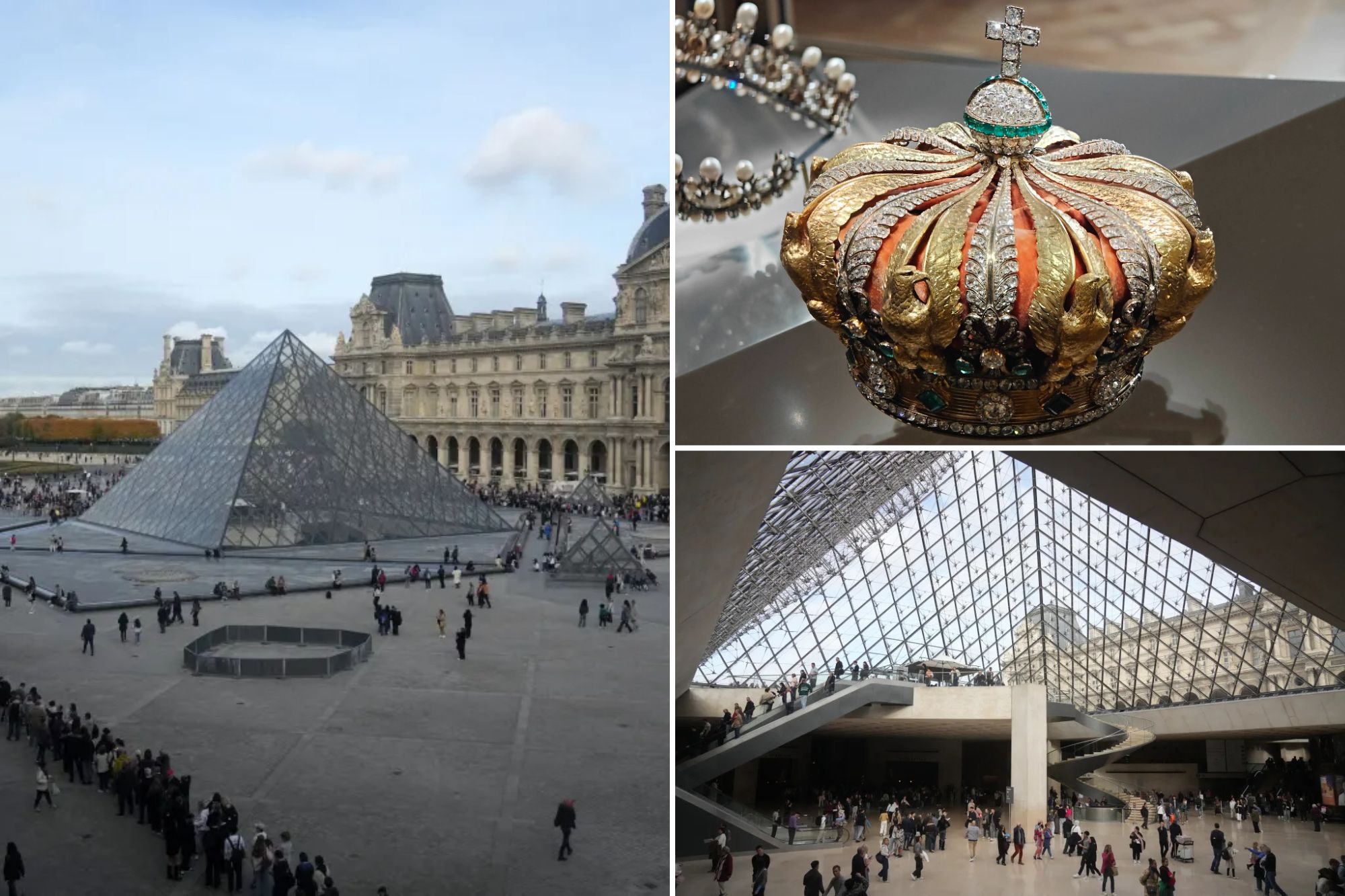World
Louvre Reopens After $102 Million Jewel Heist, Security Scrutinized

The Louvre Museum reopened on March 6, 2024, just three days after a dramatic heist that resulted in the theft of over $102 million worth of jewels from its collection. Visitors lined up beneath the iconic glass pyramid in Paris, eager to return to the world’s most-visited museum. The audacious theft, which took place under four minutes, involved the robbery of eight pieces from France’s Crown Jewels, an event that has drawn comparisons to the devastating fire at Notre-Dame Cathedral in 2019.
The theft occurred on Sunday morning, close to the renowned Mona Lisa, raising serious questions about security measures at a museum that attracts millions of visitors each year. This incident has intensified scrutiny on President Emmanuel Macron and Laurence des Cars, the Louvre’s director, especially following recent labor strikes over understaffing and inadequate security protocols.
The Heist and Immediate Aftermath
Authorities revealed that the thieves successfully maneuvered a freight lift to the Seine-facing façade, forced open a window, and shattered two vitrines within a remarkably brief timeframe. They made their escape on motorbikes before alarms could fully mobilize security personnel. Gérald Darmanin, France’s Minister of Justice, acknowledged the failure in security, stating that allowing a freight lift to be placed undetected on a public street sends a “very negative image of France.”
As the museum reopened, the Apollo Gallery, where the jewels were stolen, remained sealed. A folding screen obscured the gallery’s entrance, serving as a stark reminder of the theft. Visitors expressed disbelief at the ease with which the heist was executed. “For a place like the Louvre, it’s unfathomable,” said Amanda Lee, an art teacher from Chicago. “I heard it took under four minutes. How is that possible here, with no police in sight?”
Despite the sense of shock, some visitors remained undeterred. French lawyer Claire Martin, visiting with her children during school holidays, remarked, “We came for the art. The police can deal with the thieves.”
The Stolen Treasures and Ongoing Investigations
The stolen items included a sapphire diadem, a necklace, and an earring linked to 19th-century queens Marie-Antoinette and Hortense, as well as an emerald necklace and earrings associated with Empress Marie-Louise, the second wife of Napoleon Bonaparte. A diamond diadem belonging to Empress Eugénie and a corsage-bow brooch were also taken. Remarkably, one piece—Eugénie’s emerald-set imperial crown, adorned with over 1,300 diamonds—was later recovered outside the museum, albeit damaged.
Prosecutor Laure Beccuau estimated the total value of the stolen jewels at approximately €88 million ($102 million), emphasizing the historical significance of these items. She cautioned that the thieves would likely not realize a profit close to that figure if they attempted to dismantle the pieces for individual stones or metals, a fear shared by curators who worry about the potential destruction of cultural heritage.
Investigations are underway, with around 100 detectives currently working to identify the thieves and any accomplices. The museum’s security has come under close examination, prompting a Senate culture committee session involving Cars. Despite calls for her resignation, top officials have thus far chosen to retain her.
This incident follows Macron’s announcement in January of new security initiatives for the Louvre, including a command post and enhanced surveillance. Yet, questions remain about the effectiveness and uniformity of these upgrades, particularly in light of the heist.
The Louvre has drawn criticism for its handling of visitor flow and security, especially during peak tourist seasons. Unions argue that the influx of visitors, combined with chronic understaffing, creates vulnerabilities. Just this past June, staff protests over overcrowding had already raised alarms about the safety and security of the museum’s treasures.
As the Louvre welcomed back visitors to its other notable attractions, including the Venus de Milo and the Winged Victory of Samothrace, the empty vitrines in the Apollo Room starkly illustrated the ongoing consequences of the burglary. The incident not only raised concerns about security protocols but also highlighted the fragility of cultural patrimony in a nation grappling with the dual pressures of tourism and preservation.
-

 Lifestyle5 months ago
Lifestyle5 months agoLibraries Challenge Rising E-Book Costs Amid Growing Demand
-

 Sports4 months ago
Sports4 months agoTyreek Hill Responds to Tua Tagovailoa’s Comments on Team Dynamics
-

 Sports4 months ago
Sports4 months agoLiverpool Secures Agreement to Sign Young Striker Will Wright
-

 Lifestyle4 months ago
Lifestyle4 months agoSave Your Split Tomatoes: Expert Tips for Gardeners
-

 Lifestyle4 months ago
Lifestyle4 months agoPrincess Beatrice’s Daughter Athena Joins Siblings at London Parade
-

 Science4 months ago
Science4 months agoSan Francisco Hosts Unique Contest to Identify “Performative Males”
-

 World4 months ago
World4 months agoWinter Storms Lash New South Wales with Snow, Flood Risks
-

 Science5 months ago
Science5 months agoTrump Administration Moves to Repeal Key Climate Regulation
-

 Business5 months ago
Business5 months agoSoFi Technologies Shares Slip 2% Following Insider Stock Sale
-

 Science5 months ago
Science5 months agoNew Tool Reveals Link Between Horse Coat Condition and Parasites
-

 Sports4 months ago
Sports4 months agoElon Musk Sculpture Travels From Utah to Yosemite National Park
-

 Science5 months ago
Science5 months agoNew Study Confirms Humans Transported Stonehenge Bluestones









